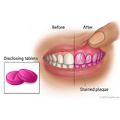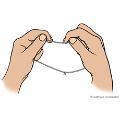Overview
Your teeth can last a lifetime if you practice basic dental care. Brush and floss each day and eat a healthy diet. See your dentist or dental hygienist for regular checkups and cleanings. Good dental health habits are the best way to prevent tooth decay and gum disease.
How to brush and floss your teeth
Brush your teeth 2 times a day, and use a toothbrush with soft bristles. Follow these tips when you brush your teeth.
- Place the brush at a 45-degree angle where the teeth meet the gums.
- Press firmly, and gently rock the brush back and forth using small circular movements.
Don't scrub. Vigorous brushing can make the gums pull away from the teeth and can scratch your tooth enamel.
- Brush all surfaces of the teeth, tongue-side and cheek-side.
Pay special attention to the front teeth and all surfaces of the back teeth.
- Brush chewing surfaces vigorously with short back-and-forth strokes.
- Consider brushing your tongue.
Some people think it makes their mouth feel more fresh, but there is no evidence that it will help with bad breath.
- Use a fluoride toothpaste.
Some fluoride toothpastes also offer tartar control, which may help slow the formation of hard mineral buildup (tartar) on the teeth.
- Use disclosing tablets every now and then to see whether any plaque remains on the teeth.
Disclosing tablets are chewable and will colour any plaque left on the teeth after you brush. You can buy them at most drugstores.
Floss at least once a day. Choose the type and flavour of floss that you like best. When you floss your teeth, use either of these methods.
- The finger-wrap method: Cut off a piece of floss 45 to 50 cm (18 to 20 in.) long. Wrap one end around your left middle finger and the other end around your right middle finger, until your hands are about 5 to 8 cm (2 to 3 in.) apart.
- The circle method: Use a piece of floss about 30 cm (12 in.) long. Tie the ends together to form a loop. If the loop is too large, wrap the floss around your fingers to make it smaller.
With either method, follow these steps for flossing.
A plastic flossing tool makes flossing easier. Child-size flossing tools are available for parents to use to floss their children's teeth. You can buy them at most drugstores.
If your gums bleed when you floss, the bleeding should stop as your gums get healthier and tighter next to your teeth.
Credits
Current as of:
November 14, 2022
Author: Healthwise Staff
Medical Review:
E. Gregory Thompson MD - Internal Medicine
Adam Husney MD - Family Medicine
Martin J. Gabica MD - Family Medicine
Arden Christen DDS, MSD, MA, FACD - Dentistry







